中国三大国粹英语演讲
介绍中国传统国粹的英语作文
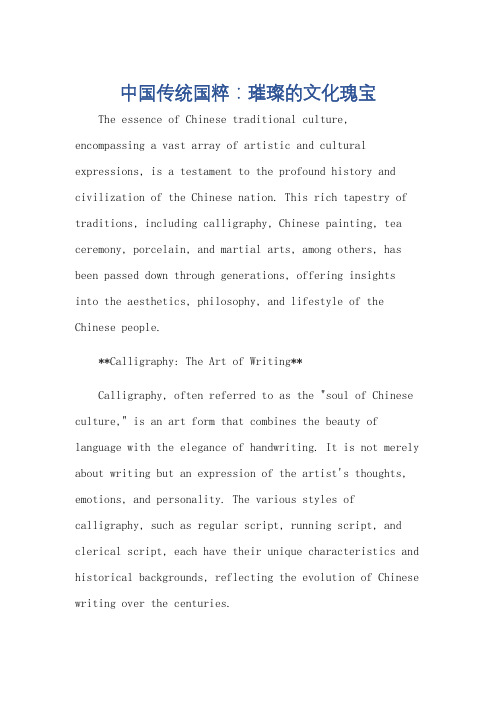
中国传统国粹:璀璨的文化瑰宝The essence of Chinese traditional culture, encompassing a vast array of artistic and cultural expressions, is a testament to the profound history and civilization of the Chinese nation. This rich tapestry of traditions, including calligraphy, Chinese painting, tea ceremony, porcelain, and martial arts, among others, has been passed down through generations, offering insightsinto the aesthetics, philosophy, and lifestyle of the Chinese people.**Calligraphy: The Art of Writing**Calligraphy, often referred to as the "soul of Chinese culture," is an art form that combines the beauty of language with the elegance of handwriting. It is not merely about writing but an expression of the artist's thoughts, emotions, and personality. The various styles of calligraphy, such as regular script, running script, and clerical script, each have their unique characteristics and historical backgrounds, reflecting the evolution of Chinese writing over the centuries.**Chinese Painting: Capturing Nature and Emotion**Chinese painting, known for its unique artistic style and profound cultural connotations, aims to capture the essence of nature and express deep emotions. It emphasizes the harmony between man and nature, reflecting the Chinese philosophy of "Taoism" and "Confucianism." Chinese painters often use ink and watercolor to create landscapes, flower and bird paintings, and figural paintings that are both realistic and abstract.**Tea Ceremony: An Ritual of Peace and Tranquility**The Chinese tea ceremony, or "Chanoyu," is a ritualized way of preparing and enjoying tea that embodies the principles of harmony, respect, purity, and tranquility. It is not just about drinking tea but an occasion for meditation, relaxation, and social interaction. The ceremony involves the selection of tea, water, and utensils, as well as the meticulous steps of brewing and serving tea, all of which contribute to the overall aesthetic experience. **Porcelain: The Elegance of Clay**Chinese porcelain, renowned for its delicate beauty and intricate craftsmanship, is a testament to the excellence of Chinese ceramics. Porcelain, made from a type of hard, water-resistant clay, has been produced in China for thousands of years, with various regions specializing in different styles and techniques. From the delicate blue and white porcelain of the Ming and Qing dynasties to the vibrant and colorful wares of the modern era, Chinese porcelain continues to captivate the world with its elegance and uniqueness.**Martial Arts: The Way of the Warrior**Martial arts, or "Wushu," is not just about combat skills but a comprehensive system of physical training,self-defense, and self-cultivation. It embodies the principles of balance, flexibility, strength, and discipline, promoting both physical and mental well-being. The various styles of martial arts, such as Kung Fu, Tai Chi, and Qigong, each have their unique characteristics and philosophical backgrounds, reflecting the diverse cultural influences of China.In conclusion, the essence of Chinese traditionalculture is a rich and diverse tapestry of artistic and cultural expressions that offer insights into the aesthetics, philosophy, and lifestyle of the Chinese people. These traditional practices, from calligraphy and paintingto tea ceremony, porcelain, and martial arts, are not just art forms but ways of life that have been passed down through generations, serving as a bridge between the past and the present, connecting people with their cultural heritage and identity.**中国传统国粹:璀璨的文化瑰宝**中国传统国粹是中华民族深厚历史和文明的见证,涵盖了各种艺术和文化表达方式。
中国十大国粹英语作文
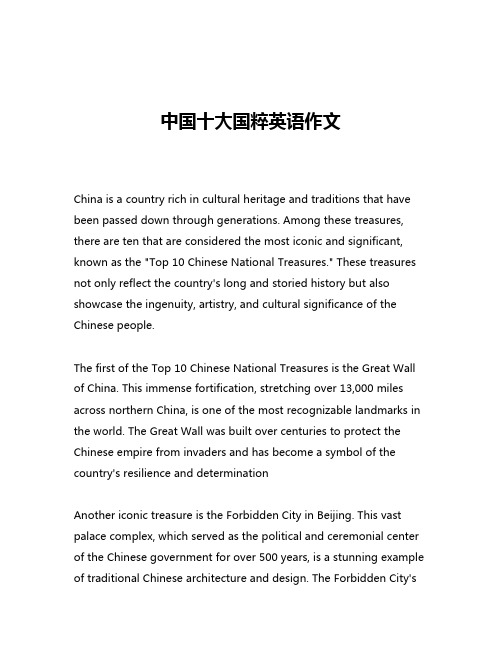
中国十大国粹英语作文China is a country rich in cultural heritage and traditions that have been passed down through generations. Among these treasures, there are ten that are considered the most iconic and significant, known as the "Top 10 Chinese National Treasures." These treasures not only reflect the country's long and storied history but also showcase the ingenuity, artistry, and cultural significance of the Chinese people.The first of the Top 10 Chinese National Treasures is the Great Wall of China. This immense fortification, stretching over 13,000 miles across northern China, is one of the most recognizable landmarks in the world. The Great Wall was built over centuries to protect the Chinese empire from invaders and has become a symbol of the country's resilience and determinationAnother iconic treasure is the Forbidden City in Beijing. This vast palace complex, which served as the political and ceremonial center of the Chinese government for over 500 years, is a stunning example of traditional Chinese architecture and design. The Forbidden City'sintricate details, grand scale, and rich history make it a must-see destination for any visitor to China.The Terracotta Warriors, discovered in the city of Xi'an, are another remarkable treasure. This vast army of life-size clay soldiers, horses, and chariots was created to protect the tomb of the first emperor of China, Qin Shi Huang. The sheer scale and attention to detail of the Terracotta Warriors have captivated people around the world and serve as a testament to the skilled craftsmanship of ancient Chinese artisans.The Yangtze River, the longest river in Asia and the third-longest in the world, is another of China's national treasures. The Yangtze has played a vital role in the country's history, serving as a crucial transportation route and a source of sustenance for millions of people. The river's stunning natural beauty, including its towering gorges and diverse ecosystems, make it a cherished part of China's cultural and environmental heritage.The Shaolin Temple, located in the Henan province, is another iconic Chinese treasure. This ancient Buddhist monastery is renowned for its martial arts traditions, which have been practiced by monks for centuries. The Shaolin Temple has become a symbol of Chinese cultural and spiritual heritage, attracting visitors from around the world who come to witness the impressive displays of kung fu andmeditation practices.The Peking Opera, a form of traditional Chinese theater that combines music, dance, and acrobatics, is another of the country's national treasures. This captivating art form has a rich history dating back to the 18th century and is celebrated for its intricate costumes, elaborate makeup, and skilled performers.The Forbidden City in Beijing is not the only imperial palace that is considered a national treasure. The Summer Palace, located in the outskirts of Beijing, is another stunning example of traditional Chinese architecture and design. This vast complex of gardens, pavilions, and lakes was once the summer retreat of the Qing dynasty emperors and is now a popular tourist destination.The Silk Road, a network of trade routes that connected China to the West, is another of the country's national treasures. This ancient network of roads, which facilitated the exchange of goods, ideas, and cultural traditions, has had a profound impact on the development of civilizations around the world. The Silk Road is celebrated for its role in promoting cross-cultural exchange and the spread of Chinese culture.The Dazu Rock Carvings, located in the Chongqing municipality, are another remarkable Chinese treasure. These intricate stone carvings,which date back to the 9th century, depict a wide range of religious and mythological figures, as well as scenes from everyday life. The Dazu Rock Carvings are a testament to the skill and artistry of ancient Chinese craftsmen and serve as a window into the country's rich cultural heritage.Finally, the Sichuan Giant Panda Sanctuaries, located in the Sichuan province, are considered one of China's national treasures. These protected areas are home to the endangered giant panda, a beloved symbol of China and a cherished part of the country's natural heritage. The Sichuan Giant Panda Sanctuaries are not only important for the conservation of the panda population but also for the preservation of the region's diverse ecosystem.These ten national treasures are just a small sampling of the rich cultural and natural heritage that China has to offer. Each of these treasures represents a unique aspect of the country's history, traditions, and ingenuity, and they serve as a testament to the enduring spirit and creativity of the Chinese people. Whether you are a history buff, a nature lover, or simply someone who appreciates the beauty and complexity of human civilization, these national treasures are well worth discovering and exploring.。
介绍中国传统国粹的英语作文

介绍中国传统国粹的英语作文China is a country with a rich cultural heritage, andone of the most important aspects of this heritage is its traditional national essence. Traditional national essence, or guócuì (国粹) in Chinese, refers to the quintessential elements of Chinese culture that have been passed down through generations. These elements encompass a wide rangeof cultural practices, such as calligraphy, Chinese opera, martial arts, and tea culture, all of which have played a significant role in shaping Chinese identity and values.Calligraphy, known as shūfǎ (书法) in Chinese, is considered an important art form in China. It involves the skilled and artistic writing of Chinese characters with a brush and ink. Calligraphy has been highly regarded in Chinese culture for thousands of years and is seen as a reflection of one's character and inner emotions. It isoften practiced as a form of meditation and self-expression.Chinese opera, or jīngjù (京剧), is anothertraditional national essence that has been cherished by the Chinese people for centuries. It combines music, singing, and acrobatics to tell stories from Chinese history andfolklore. The elaborate costumes, makeup, and stylized movements make Chinese opera a visually stunning and culturally significant art form.Martial arts, or wǔshù (武术), have a long and revered history in China. They encompass a variety of fighting styles and techniques, each with its own principles and philosophies. Martial arts are not only a form of self-defense but also a way to cultivate discipline, resilience, and spiritual growth.Tea culture, or cháwénhuà (茶文化), is deeply rooted in Chinese society and has a history dating back thousands of years. The practice of brewing and enjoying tea is an integral part of Chinese social interactions and has been elevated to an art form. Chinese tea ceremonies emphasize harmony, respect, and tranquility, reflecting traditional Chinese values.These traditional national essences are not only a source of pride for the Chinese people but also serve as a bridge to connect the past with the present. They embody the enduring spirit and wisdom of Chinese culture, andcontinue to inspire and enrich the lives of people aroundthe world.中国拥有丰富的文化传统,其中最重要的部分之一就是其传统国粹。
十大国粹介绍英语作文
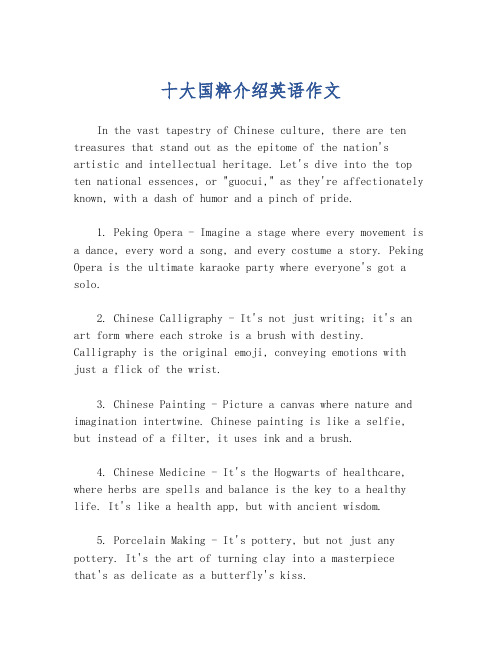
十大国粹介绍英语作文In the vast tapestry of Chinese culture, there are ten treasures that stand out as the epitome of the nation's artistic and intellectual heritage. Let's dive into the top ten national essences, or "guocui," as they're affectionately known, with a dash of humor and a pinch of pride.1. Peking Opera - Imagine a stage where every movement isa dance, every word a song, and every costume a story. Peking Opera is the ultimate karaoke party where everyone's got a solo.2. Chinese Calligraphy - It's not just writing; it's an art form where each stroke is a brush with destiny. Calligraphy is the original emoji, conveying emotions with just a flick of the wrist.3. Chinese Painting - Picture a canvas where nature and imagination intertwine. Chinese painting is like a selfie, but instead of a filter, it uses ink and a brush.4. Chinese Medicine - It's the Hogwarts of healthcare, where herbs are spells and balance is the key to a healthy life. It's like a health app, but with ancient wisdom.5. Porcelain Making - It's pottery, but not just any pottery. It's the art of turning clay into a masterpiecethat's as delicate as a butterfly's kiss.6. Tang Suit - It's the fashion statement that says, "I'm not just a trendsetter; I'm a trend-ancestor." The Tang Suit is the OG of fashion, with a style that's timeless.7. Chinese Tea Culture - It's not just a drink; it's a ceremony, a ritual, and a sip of history. Drinking tea hereis like time travel, with each cup taking you back to ancient dynasties.8. Chinese Martial Arts - It's the gym for the soul, where every punch is a lesson in discipline and every kick is a step towards inner peace.9. Paper Cutting - It's the art of saying a lot with a little. Paper cutting is like a silent poet, telling stories without a word.10. Chinese Silk - It's the fabric of dreams, as smooth as a whisper and as elegant as a waltz. Wearing silk is like wrapping yourself in a cloud.These ten treasures are the heart and soul of China'srich cultural legacy. They're not just traditions; they're a living, breathing testament to the ingenuity and creativity of a nation that's been crafting history for millennia. So, the next time you're feeling down, remember, there's a Chinese art form out there that's got your back, whether it's a soothing cup of tea or a kick-butt martial arts move.。
十大国粹介绍英语作文
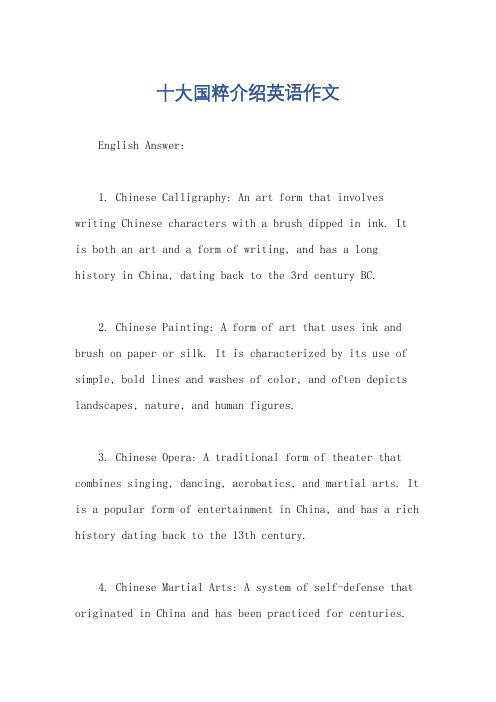
十大国粹介绍英语作文English Answer:1. Chinese Calligraphy: An art form that involves writing Chinese characters with a brush dipped in ink. It is both an art and a form of writing, and has a longhistory in China, dating back to the 3rd century BC.2. Chinese Painting: A form of art that uses ink and brush on paper or silk. It is characterized by its use of simple, bold lines and washes of color, and often depicts landscapes, nature, and human figures.3. Chinese Opera: A traditional form of theater that combines singing, dancing, acrobatics, and martial arts. It is a popular form of entertainment in China, and has a rich history dating back to the 13th century.4. Chinese Martial Arts: A system of self-defense that originated in China and has been practiced for centuries.There are many different styles of Chinese martial arts, each with its own unique techniques and principles.5. Chinese Paper Cutting: A folk art that involves cutting designs out of paper. It is often used to decorate windows, doors, and other objects, and is a popular way to celebrate festivals and holidays.6. Chinese Porcelain: A type of fine ceramic that is made from kaolin clay and fired at high temperatures. It is known for its delicate texture, translucency, and beautiful designs.7. Chinese Silk: A natural fiber that is produced by silkworms. It is a luxurious and versatile fabric that is used to make clothing, bedding, and other products.8. Chinese Tea: A type of tea that is made from the leaves of the Camellia sinensis plant. It is a popular beverage in China and around the world, and has many health benefits.9. Chinese Cuisine: A diverse and delicious cuisine that is known for its use of fresh ingredients, bold flavors, and variety of dishes. It is one of the most popular cuisines in the world.10. Chinese Traditional Medicine: A system of medicine that has been practiced in China for centuries. It uses a variety of natural substances, such as herbs, acupuncture, and massage, to treat a wide range of illnesses.中文回答:1. 国粹,中国传统文化的代表性事物。
中国十大国粹的演讲稿英语
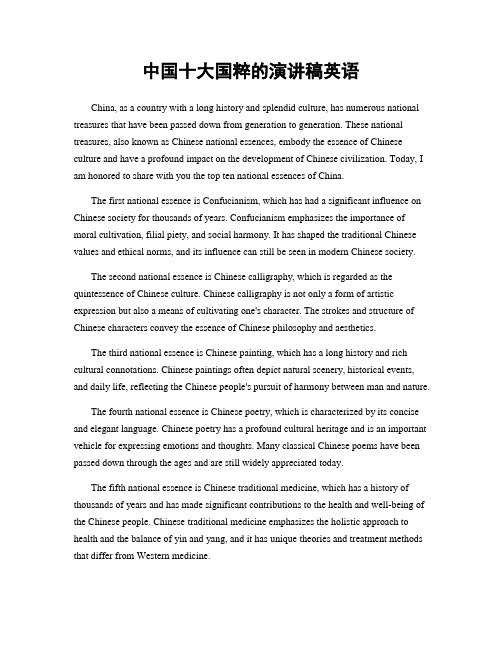
中国十大国粹的演讲稿英语China, as a country with a long history and splendid culture, has numerous national treasures that have been passed down from generation to generation. These national treasures, also known as Chinese national essences, embody the essence of Chinese culture and have a profound impact on the development of Chinese civilization. Today, I am honored to share with you the top ten national essences of China.The first national essence is Confucianism, which has had a significant influence on Chinese society for thousands of years. Confucianism emphasizes the importance of moral cultivation, filial piety, and social harmony. It has shaped the traditional Chinese values and ethical norms, and its influence can still be seen in modern Chinese society.The second national essence is Chinese calligraphy, which is regarded as the quintessence of Chinese culture. Chinese calligraphy is not only a form of artistic expression but also a means of cultivating one's character. The strokes and structure of Chinese characters convey the essence of Chinese philosophy and aesthetics.The third national essence is Chinese painting, which has a long history and rich cultural connotations. Chinese paintings often depict natural scenery, historical events, and daily life, reflecting the Chinese people's pursuit of harmony between man and nature.The fourth national essence is Chinese poetry, which is characterized by its concise and elegant language. Chinese poetry has a profound cultural heritage and is an important vehicle for expressing emotions and thoughts. Many classical Chinese poems have been passed down through the ages and are still widely appreciated today.The fifth national essence is Chinese traditional medicine, which has a history of thousands of years and has made significant contributions to the health and well-being of the Chinese people. Chinese traditional medicine emphasizes the holistic approach to health and the balance of yin and yang, and it has unique theories and treatment methods that differ from Western medicine.The sixth national essence is Chinese tea culture, which has a history of over a thousand years. Chinese tea culture embodies the spirit of harmony, respect, and tranquility. It has had a profound impact on Chinese social customs and etiquette, and it is an important part of Chinese people's daily lives.The seventh national essence is Chinese cuisine, which is known for its diversity and exquisite flavors. Chinese cuisine reflects the Chinese people's pursuit of harmony in color, aroma, taste, and presentation. It has a long history and has evolved into various regional cuisines with unique characteristics.The eighth national essence is Chinese traditional music, which has a history of thousands of years and is an important part of Chinese cultural heritage. Chinese traditional music encompasses a wide range of instruments and styles, and it reflects the Chinese people's sentiments and aspirations.The ninth national essence is Chinese martial arts, which has a long history and profound cultural connotations. Chinese martial arts emphasize the integration of body, mind, and spirit, and they embody the Chinese people's pursuit of physical and mental cultivation.The tenth national essence is Chinese traditional festivals, which are an important part of Chinese cultural traditions. Chinese traditional festivals, such as the Spring Festival, Dragon Boat Festival, and Mid-Autumn Festival, reflect the Chinese people's values, beliefs, and customs.In conclusion, the top ten national essences of China are the embodiment of Chinese culture and have played a significant role in shaping the Chinese civilization. These national essences are not only valuable cultural heritage but also a source of inspiration for the Chinese people to carry forward their traditions and promote cultural exchange with the world. Thank you.。
英语课前展示国粹-京剧国画和中医

中国京剧是中国的"国粹.是中国最大戏曲剧种 。其剧目之丰富、表演艺术家之多、剧团之多 、观众之多、影响之深均为全国之冠。京剧是 综合性表演艺术。集唱(歌唱)、念(念白) 、做(表演)、打(武打)、舞(舞蹈)为一体 、通过程式的表演手段叙演故事,刻划人物, 表达"喜、怒、哀、乐、惊、恐、悲"思想感情 。角色可分为:生(男人)、旦(女人)、净 (男人)、丑(男、女人皆有)四大行当。人 物有忠奸之分,美丑之分、善恶之分。各个形 象鲜明、栩栩如生。
Chinese painting
Chinese painting is one of the oldest continuous artistic traditions in the world. Painting in the traditional style is known today in Chinese as Guohua.Traditional Chinese painting is done with a brush dipped in black or colored ink. The most popular materials for paintings are paper and silk.The finished work can be mounted on scrolls, such as hanging scrolls or handscrolls.The earliest paintings were not representational but ornamental; they consisted of patterns or designs rather than pictures.
用描述中国国粹的英语作文
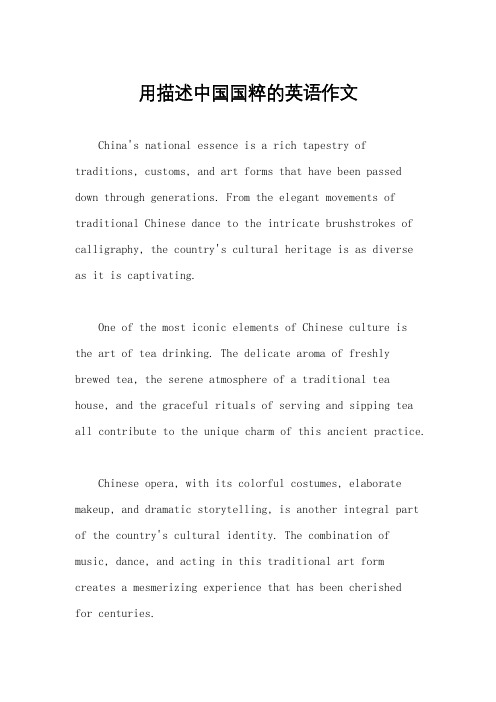
用描述中国国粹的英语作文China's national essence is a rich tapestry of traditions, customs, and art forms that have been passed down through generations. From the elegant movements of traditional Chinese dance to the intricate brushstrokes of calligraphy, the country's cultural heritage is as diverse as it is captivating.One of the most iconic elements of Chinese culture isthe art of tea drinking. The delicate aroma of freshly brewed tea, the serene atmosphere of a traditional tea house, and the graceful rituals of serving and sipping tea all contribute to the unique charm of this ancient practice.Chinese opera, with its colorful costumes, elaborate makeup, and dramatic storytelling, is another integral part of the country's cultural identity. The combination of music, dance, and acting in this traditional art form creates a mesmerizing experience that has been cherishedfor centuries.The Great Wall of China stands as a testament to the country's rich history and enduring spirit. Spanning thousands of miles and dating back to ancient times, this architectural marvel is a symbol of China's strength, resilience, and determination.The traditional Chinese qipao, with its figure-hugging silhouette and exquisite embroidery, is a timeless representation of elegance and grace. This iconic garment has evolved over the centuries, yet it remains a symbol of feminine beauty and sophistication.The art of Chinese paper cutting, with its intricate designs and symbolic motifs, is a cherished folk tradition that has been passed down through countless generations. From auspicious symbols to intricate patterns, each piece of paper cutting reflects the creativity and craftsmanship of its creator.Chinese calligraphy is a revered art form that combines the beauty of written language with the expressive power ofbrush and ink. The graceful strokes and rhythmic flow of Chinese characters convey a sense of harmony and balance that is deeply rooted in the country's cultural heritage.Traditional Chinese medicine, with its emphasis on holistic healing and natural remedies, has been practiced for thousands of years. From acupuncture and herbal medicine to tai chi and qigong, these ancient practices continue to play a vital role in the health and well-being of the Chinese people.The vibrant colors and intricate patterns of Chinese embroidery reflect the country's rich cultural heritage and artistic traditions. From elaborate silk tapestries to delicate handkerchiefs, each piece of embroidery is a testament to the skill and creativity of its maker.The ancient art of feng shui, with its emphasis on creating harmony and balance in the environment, is deeply ingrained in Chinese culture. From the layout of homes and buildings to the arrangement of furniture and decor, fengshui principles continue to influence the way people live and work in China.。
